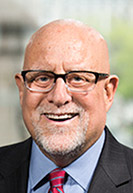Subscriber Benefit
As a subscriber you can listen to articles at work, in the car, or while you work out. Subscribe NowTo fill its roster with the best attorneys at a time when the legal profession is struggling to keep pace with changes in technology and the marketplace, Taft Stettinius & Hollister LLP has turned to an old idea.
The firm announced a revamped partnership structure in January. It abandoned the two-tier format that divided the partners into being either equity or non-equity in favor of a single-tier, equity-only structure. In conjunction with the switch, more than 100 non-equity partners were promoted to equity.
 Hicks
HicksRobert Hicks, Taft’s chairman and managing partner, heralded the change as a great day for the 132-year-old firm. For a quarter of a decade, Taft partners had been categorized as either equity or non-equity, but Hicks said the structure had outlived its usefulness.
Non-equity partners, Hicks said, often felt like second-class partners because they had no voting rights and were ineligible for leadership positions. In particular, young lawyers were not as content to warm the bench. As Hicks explained, the new generation of attorneys want to be in leadership positions, have their voices heard and be able to access more compensation.
The single-tier system, he said, will allow younger lawyers to assume leadership roles sooner and make more money faster.
At the heart of the decision to switch is the desire to gain a competitive edge in attracting and retaining talent. Last year, the firm instituted a new family leave policy to give employees more flexibility. Also, it no longer requires attorneys retire when their birthday cake has 70 candles. Hicks said Taft is trying to be a modern firm that responds to the demands of the lawyers.
Sang Lee, CEO of Volta Talent Strategies LLC, called Taft’s partnership change a “bold move.” She is seeing law firms return to a one-tier structure although they may not automatically elevate non-equity partners as Taft did.
As she noted, the practice of law is shifting. How lawyers work, where and when they work, how they bill and what resources they have to help them are all changing. So, law firms wanting to attract and retain high-performing attorneys are looking at partnership incentives as well as categories outside the traditional associate and partnership slots to include non-partner and in-house tracks.
Still, firms have to be diligent when they change their partnership structure. They have to look at their mission and how they do business to determine what fits best for them.
“I absolutely do not think law firms should follow suit just because a competitor down the street is doing something,” Lee said.
Recruit and retain
Until the 1980s, the one-tier partnership structure was the norm for most law firms. The pressure on associates was intense as they had to perform and move up to equity status or get out and go someplace else.
However, as William Henderson detailed in a 2006 article for the North Carolina Law Review, the one-tier raised some suspicions. There were concerns that once some lawyers made partner, they would slack off but still continue to get a slice of the profits brought in by the more aggressive attorneys.
Henderson, professor at Indiana University Maurer School of Law, has extensively studied the legal profession and legal education.
The two-tier structure was seen as a solution. High-performers could become equity partners and have an ownership stake while talented legal technicians and specialists could get non-equity status. Under this model, the rainmakers would earn higher incomes and the up or out rule would be relaxed, allowing capable associates who were not partnership material to stay.
Hicks emphasized Taft switched because of the potential for attorneys to be kept down in the two-tier model. Now, all the new equity partners have “skin in the game,” but the firm is easing their transition.
Although all 240 partners will have to make an equity contribution, the new arrivals have a nine-month grace period before they have pay into the firm. In addition, partners whose income is above a certain threshold will all pay the same percentage while partners below the threshold will contribute at lower percentages based on how low their revenue is.
 Liebster
LiebsterJeff Liebster, partner at the international legal recruiting firm Major Lindsey & Africa, is seeing more firms go in the same direction as Taft but calling it a two-tier structure. They are accepting lower capital contributions from junior partners because of the robust market for laterals.
“When a high-performing attorney joins a new firm, he or she is usually accompanied by a team of junior lawyers. These team members do not always have sizable books of business that would qualify them for equity status and the requirement for a full equity investment may result in a financial burden,” Liebster said. “It is in the lateral and the firm’s best interests to bring these lawyers in with the title of ‘partner’ in order to facilitate the attraction of clients and the building of a practice. The non-equity tier gives the lateral the status, without the expense.”
Along with the partners, Taft also has 57 of counsel, 13 senior counsel and 109 associates. For those looking to move up, Lee and Henderson both said the path to partner could become narrower.
Across the market, the demand for legal services remains flat and attorneys are having a harder time originating new clients. Single-tier firms could get into an economic tangle if the money does not grow at a rate that allows the partners to maintain their lifestyles.
In addition, evaluating performance and determining the equity contribution of each partner is becoming more arduous. This is because the traditional measuring stick, the billable hour, is no longer viable as firms offer flat fees and agree to cap costs for certain clients.
Lawyers will have to be valued in differently, Lee and Henderson said. Firms will likely want to keep some partners even though they do not bring in much revenue. Attorneys can be prized for their relationships, project management skills, or for their expertise in a certain area of the law.
Henderson sees Taft’s move as engaging more of the lawyers in the firm’s future. Conversations are good, he said, and should include all partners as well as senior associates.
“You can’t get a great firm without engaging everybody,” Henderson said.•
Please enable JavaScript to view this content.
